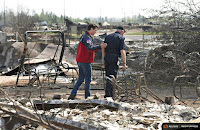As firefighters continue their struggle to contain the destructive forest fire that has already ravaged Fort McMurray, Alberta, new evidence shows that global warming will rapidly increase the risk of wildfires across northern regions of Europe, North America and Asia.
That includes Alaska, where the likelihood of fires will grow up to fourfold in coming decades in areas where they have been rare. That puts at risk the edges of vast boreal forests, as well as tundra zones, according to a new study published in the journal Ecography.
"We know some of these areas haven't burned in thousands of years," said University of Montana fire ecology researcher Philip Higuera, who led the study along with Adam Young, an affiliate scientist at the University of Montana.
Across the state's North Slope, above the Arctic Circle, the shift is "far outside the range of natural variability we've seen in the last 6,000 to 32,000 years," Higuera said.
Increased wildfire activity will change the shape and extent of boreal forests, and affect wildlife habitat and Alaska's indigenous residents. And while climate change is the prime culprit, the fires will also intensify global warming. Burning organic soils and thawing permafrost will send even more CO2 into the atmosphere, according to Higuera and other scientists who study ecosystem changes in the region.
Read more at Global Warming to Spur More Fires in Alaska, in Turn Causing More Warming

No comments:
Post a Comment